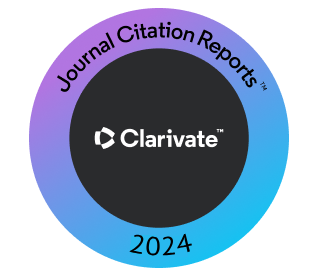Gene Polymorphism of Antigen B Subunit 2 and Pathogenesis of Cystic Echinococcosis in Murine Model
Abstract
A complex genetic diversity among the causative agent, Echinococcus granulosus, is documented. Antigen B (AgB) is a major antigenic fraction of hydatid fluid and hydatid cyst tissues. This study aims to investigate the role of antigen B subunit 2 (AgB2) gene polymorphism in the pathogenesis of cystic echinococcosis (CE) in murine model. Ovine liver hydatid cysts are obtained from Erbil Slaughterhouse. Protoscoleces from each isolate are separated into two batches. First preserved at −20°C for molecular analysis whereas the second is used for experimental infection in mice. Parasite DNA was extracted, and AgB2 genome was amplified and sequenced. The sequencing profile of six of the isolates (1, 2, 3, 5, 8, and 11) revealed a 100% analogy with AgB2 gene of E. granulosus genotype G2. Minor sequence polymorphisms, 1.67%, are observed in one of the isolates, whereas remarkable DNA sequence polymorphisms are noticed in three of the isolates. The polymerase chain reaction (PCR) products sequencing profiles revealed 100% polymorphisms in four of the isolates in comparison with the source gene (AY569356.1), instead, those isolates reveal various degrees of analogy, 80.33%, 80.87–89.05%, and 89.36% to G1, G3, and G6, respectively. Polymorphic sequencing profile of the PCR-amplified product (250 bp) of E. granulosus clone EgB2G2v13 AgB2 gene (Accession no.: AY569356.1) has no significant impact on the pathogenicity of the CE in murine model. To upgrade the diagnostic sensitivity rates of the immunological techniques, a mixture of native hydatid antigens containing AgB is recommended to be used in the ser-diagnosis of this infection.
Downloads
References
Abbas, I.E.A., Al-Kappany, Y.M., and Al-Araby, M.A., 2016. Prevalence and molecular characterization of hydatid cyst isolates from cattle in Egypt. Asian Journal of Animal and Veterinary Advances, 11(12), pp.794-804. DOI: https://doi.org/10.3923/ajava.2016.794.804
Al-Olayan, E.M., and Helmy, H., 2012. Diagnostic value of different antigenic fractions of hydatid cyst fluid from camel and sheep in Kingdom of Saudi Arabia. Journal of Saudi Chemical Society, 16(2), pp.203-207. DOI: https://doi.org/10.1016/j.jscs.2011.01.001
Al-sakee, H.M.A., 2011. Immunological aspects of cystic echinococcosis in Erbil. Zanco Journal of Medical Sciences, 15(2), pp.1-9. DOI: https://doi.org/10.15218/zjms.2011.013
Alsakee, H.M.A., 2023. Diagnostic efficiency of heat shocked protoscoleces extract antigens for human cystic echinococcosis by ELISA. Iraqi Journal of Science, 64(1), pp.65-74. DOI: https://doi.org/10.24996/ijs.2023.64.1.7
Alvarez Rojas, C.A., Romig, T., and Lightowlers, M.W., 2014. Echinococcus granulosus sensu lato genotypes infecting humans--review of current knowledge. International Journal for Parasitology, 44, pp.9-18. DOI: https://doi.org/10.1016/j.ijpara.2013.08.008
Babaei, Z., Taherkhani, R., Barazesh, A., Taherzadeh, M., Khorami, S., and Fouladvand, M., 2021. Genotyping and phylogenetic analysis of hydatid cysts isolated from livestock in Bushehr province, Iran. Journal of Parasitic Diseases, 45(1), pp.197-203. DOI: https://doi.org/10.1007/s12639-020-01293-7
Beyhan, Y.E., Albayrak, C., and Guven, I., 2022. IL-4, IL-10, TNF-α and IFN-γ cytokine levels in patients with cystic echinococcosis and fascioliasis. Iranian Journal of Public Health, 51(6), pp.1339-1347. DOI: https://doi.org/10.18502/ijph.v51i6.9679
Casulli, A., Massolo, A., Saarma, U., Umhang, G., Santolamazza, F., and Santoro, A., 2022. Species and genotypes belonging to Echinococcus granulosus sensu lato complex causing human cystic echinococcosis in Europe (2000-2021): A systematic review. Parasites and Vectors, 15(1), p.109. DOI: https://doi.org/10.1186/s13071-022-05197-8
Da Silva, E.D., Cancela, M., Monteiro, K.M., Ferreira, H.B., and Zaha, A., 2018. Antigen B from Echinococcus granulosus enters mammalian cells by endocytic pathways. PLoS Neglected Tropical Diseases, 12(5), p.e0006473. DOI: https://doi.org/10.1371/journal.pntd.0006473
Ebrahimipour, M., Sadjjadi, S.M., Yousofi Darani, H., and Najjari, M., 2017. Molecular studies on cystic echinococcosis of camel (Camelus dromedarius) and report of Echinococcus ortleppi in Iran. Iranian Journal of Parasitology, 12(3), pp.323-331.
Elmajdoub, L.O., and Rahman, W.A., 2015. Prevalence of hydatid cysts in slaughtered animals from different areas of Libya. Open Journal of Veterinary Medicine, 5, p.1-10. DOI: https://doi.org/10.4236/ojvm.2015.51001
Ergin, S., Saribas, S., and Yuksel, P., 2010. Genotypic characterisation of Echinococcus granulosus isolated from human in Turkey. African Journal of Microbiology Research, 4(7), pp.551-555.
Esfedan, A.F., Sarkari, B., and Mikaeili, F., 2018. Genetic variability of antigen B8/1 among Echinococcus granulosus isolates from human, cattle, and sheep in Fars Province, Southern Iran. Reports of Biochemistry and Molecular Biology, 6(2), pp.164-169.
Hamoo, R.N., Mustafa, N.G., and Abdulraheem, S.A., 2019. Nad1 gene analysis of Echinococcus granulosus from sheep in Aqrah city, Iraq. Iraqi Journal of Veterinary Sciences, 33(2), pp.341-345. DOI: https://doi.org/10.33899/ijvs.2019.162965
Hassan, H., AL-Hadithi, T.S., and Al-Sakee, H.M., 2016. Experimental trial with a heat-shocked protoscolex extract as a vaccine candidate for protection against hydatid disease. Turkish Journal of Parasitology, 40(1), pp.1-8. DOI: https://doi.org/10.5152/tpd.2016.3993
Hogea, M.O., Ciomaga, B.F., Muntean, M.M., Muntean, A.A., Popa, M.I., and Popa, G.L., 2024. Cystic echinococcosis in the early 2020s: A review. Tropical Medicine and Infectious Disease, 9(2), p.36. DOI: https://doi.org/10.3390/tropicalmed9020036
Kamenetzky, L., Muzulin, P.M., Gutierrez, A.M., Angel, S.O., Zaha, A., Guarnera, E.A., and Rosenzvit, M.C., 2005. High polymorphism in genes encoding antigen B from human infecting strains of Echinococcus granulosus. Parasitology, 131(Pt 6), pp.805-815. DOI: https://doi.org/10.1017/S0031182005008474
Khalf, M.S., Al-Faham, M.A., Al-Taie, L.H., and Alhussian, H.A., 2014. Genotyping of Echinococcus granulose in Samples of Iraqi Patients. IOSR Journal of Pharmacy and Biological Sciences, 9(3), pp.6-10. DOI: https://doi.org/10.9790/3008-09320610
Khoshnaw, K.J.S., and Al-Sakee, H.M.A., 2022. Cystic echinococcosis and host interleukin-2, interleukin-9 and interleukin-10 as biomarkers for evaluation of albendazole and praziquantel treatment in experimentally infected mice. Indian Journal of Pharmaceutical Sciences, 84, pp.246-254. DOI: https://doi.org/10.36468/pharmaceutical-sciences.spl.439
Kinkar, L., Laurimäe, T., Sharbatkhori, M., Mirhendi, H., Kia, E.B., PonceGordo, F., Andresiuk, V., Simsek, S., Lavikainen, A., Irshadullah, M., Umhang, G., Oudni-M’rad, M., Acosta-Jamett, G., Rehbein, S., and Saarma, U., 2017. New mitogenome and nuclear evidence on the phylogeny and taxonomy of the highly zoonotic tapeworm Echinococcus granulosus sensu stricto. Infection, Genetics and Evolution, 52, pp.52-58. DOI: https://doi.org/10.1016/j.meegid.2017.04.023
Li, Z., Zhang, C., Li, L., Bi, X., Li, L., Yang, S., Zhang, N., Wang, H., Yang, N., Abulizi, A., Aini, A., Lin, R., Vuitton, D.A., and Wen, H., 2019. The local immune response during Echinococcus granulosus growth in a quantitative hepatic experimental model. Scientific Reports, 9(1), p.19612. DOI: https://doi.org/10.1038/s41598-019-56098-3
Lorenzo, C., Ferreira, H.B., Monteiro, K.M., Rosenzvit, M., Kamenetzky, L., García, H.H., Vasquez, Y., Naquira, C., Sánchez, E., Lorca, M., Contreras, M., Last, J.A., and González-Sapienza, G.G., 2005. Comparative analysis of the diagnostic performance of six major Echinococcus granulosus antigens assessed in a double-blind, randomized multicenter study. Journal of Clinical Microbiology, 43, pp.2764-2770. DOI: https://doi.org/10.1128/JCM.43.6.2764-2770.2005
Ma, X.M., Bao, G.S.H., Wan, J.M., Liao, D.J., Yin, S.H.F., Meng, X.Q., Zhou, G.K., Lu, X.M., and Li, H.Y., 2007. Therapeutic effects of Sophora moorcroftiana alkaloids in combination with albendazole in mice experimentally infected with protoscolices of Echinococcus granulosus. Brazilian Journal of Medical and Biological Research, 40(10), pp.1403-1408. DOI: https://doi.org/10.1590/S0100-879X2006005000167
Macin, S., Orsten, S., Samadzade, R., Colak, B., Cebeci, H., and Fındık, D., 2021. Human and animal cystic echinococcosis in Konya, Turkey: Molecular identification and the first report of E. equinus from human host in Turkey. Parasitology Research, 120(2), pp.563-568. DOI: https://doi.org/10.1007/s00436-021-07050-w
Maglioco, A., Gentile, J., Barbery Venturi, M.S., Jensen, O., Hernández, C., Gertiser, M.L., Poggio, V., Canziani, G., and Fuchs, A.G., 2019. Detection of Echinococcus granulosus sensu lato infection by using extracts derived from a protoscoleces G1 cell line. Parasite Immunology, 41(12), p.e12674. DOI: https://doi.org/10.1111/pim.12674
Mahdi, Z.M.S., Al-Hamairy, A.K., and Al-Rubaiey, H.M., 2020. Genotyping of Echinococcus granulosus isolates from human, sheep and cattles hydatid cysts in some central euphrates provinces, Iraq. Medico-Legal Update, 20(2), pp.570-575.
Mardani, P., Ezabadi, A.T., Sedaghat, B., and Sadjjadi, S.M., 2021. Pulmonary hydatidosis genotypes isolates from human clinical surgery based on sequencing of mitochondrial genes in Fars, Iran. Journal of Cardiothoracic Surgery, 16(1), p.167. DOI: https://doi.org/10.1186/s13019-021-01547-2
Metwally, D.M., Qassim, L.E., Al-Turaiki, I.M., Almeer, R.S., and ElKhadragy, M.F., 2018. Gene-based molecular analysis of COX1 in Echinococcus granulosus cysts isolated from naturally infected livestock in Riyadh, Saudi Arabia. PLoS One, 13(4), p.e0195016. DOI: https://doi.org/10.1371/journal.pone.0195016
Nusrath, N.K., Khader Faheem, N., Syama Sundara Rao, B., and Raja Ram, G., 2013. The scenario of Hydatid cyst disease in epidemic areas of Andhra Pradeshevaluation and analysis. International Journal of Research and Development of Health, 1, pp.120-128. DOI: https://doi.org/10.70729/2130928
Pal, M., and Dutta, J.B., 2013. Echinococcosis -an emerging and re-emerging cyclozoonosis of global importance. International Journal of Livestock Research, 3(3), pp.5-12. DOI: https://doi.org/10.5455/ijlr.20130929085504
Patra, G., Ghosh, S., Behera, B., Bhattacharyay, P., Arya, R.S., Alam, S.S., and Maity, I., 2021. A brief review on Echinococcosis and its perspective in public health point of view. 32(6), pp. 23-45.
Piccoli, L., Bazzocchi, C., Brunetti, E., Mihailescu, P., Bandi, C., Mastalier, B., Cordos, I., Beuran, M., Popa, L.G., Meroni, V., Genco, F., and Cretu, C., 2013. Molecular characterization of Echinococcus granulosus in South-Eastern Romania: Evidence of G1-G3 and G6-G10 complexes in humans. Clinical Microbiology and Infection, 19(6), pp.578-582. DOI: https://doi.org/10.1111/j.1469-0691.2012.03993.x
Riganò, R., Buttari, B., Profumo, E., Ortona, E., Delunardo, F., Margutti, P., Mattei, V., Teggi, A., Sorice, M., and Siracusano, A., 2007. Echinococcus granulosus antigen B impairs human dendritic cell differentiation and polarizes immature dendritic cell maturation towards a Th2 cell response. Infection and Immunity, 75(4), pp.1667-1678. DOI: https://doi.org/10.1128/IAI.01156-06
Riganò, R., Profumo, E., Bruschi, F., Carulli, G., Azzarà, A., Ioppolo, S., Buttari, B., Ortona, E., Margutti, P., Teggi, A., and Siracusano, A., 2001. Modulation of human immune response by Echinococcus granulosus antigen B and its possible role in evading host defenses. Infection and Immunity, 69(1), pp.288-296. DOI: https://doi.org/10.1128/IAI.69.1.288-296.2001
Rostami Nejad, M., Taghipour, N., Nochi, Z., Mojarad, E.N., Mohebbi, S.R., Harandi, M.F., and Zali, M.R., 2012. Molecular identification of animal isolates of Echinococcus granulosus from Iran using four mitochondrial genes. Journal of Helminthology, 86(4), pp.485-492. DOI: https://doi.org/10.1017/S0022149X1100071X
Sadjjadi, S.F., Mohammadzadeh, T., Hafezi, F., and Sadjjadi, S.M., 2022. Evaluation of the ability of antigen B originated from Echinococcus granulosus sensu stricto and E. canadensis for the diagnosis of confirmed human cystic echinococcosis using ELISA. Iranian Journal of Parasitology, 17(3), pp.358-365. DOI: https://doi.org/10.18502/ijpa.v17i3.10626
Sarkari Shahriari, B., Biranvand, E., Sadjjadi, S.M., and Rahimi, H., 2013. Genetic variability of antigen B2 of human, sheep, goats, camel and cattle isolates of Echinococcus granulosus in Iran. Iranian Journal of Parasitology, 8(4), pp.545-551.
Shahbazi, A.E., Saidijam, M., Maghsood, A.M., Matini, M., Motavali Haghi, M., and Fallah, M., 2020. Genotyping of fresh and parafinized human hydatid cysts using nad1 and cox1 genes in Hamadan province, West of Iran. Iranian Journal of Parasitology, 15(2), pp.259-265. DOI: https://doi.org/10.18502/ijpa.v15i2.3309
Shao, G., Hua, R., Song, H., Chen, Y., Zhu, X., Hou, W., Li, S., Yang, A., and Yang, G., 2023. Protective efficacy of six recombinant proteins as vaccine candidates against Echinococcus granulosus in dogs. PLoS Neglected Tropical Diseases, 17(10), p.e0011709. DOI: https://doi.org/10.1371/journal.pntd.0011709
Shariatzadeh, S.A., Spotin, A., Gholami, S., Fallah, E., Hazratian, T., MahamiOskouei, M., Montazeri, F., Moslemzadeh, H.R., and Shahbazi, A., 2015. The first morphometric and phylogenetic perspective on molecular epidemiology of Echinococcus granulosus sensu lato in stray dogs in a hyperendemic Middle East focus, Northwestern Iran. Parasites and Vectors, 8(1), p.409. DOI: https://doi.org/10.1186/s13071-015-1025-9
Shirazi, S., Madani, R., Hoghooghi Rad, N., and Ranjbar Bahadori, S., 2016. Isolation and purification of Echinococcus granulosus antigen B from hydatid cyst fluid using three different methods. Archives of Razi Institute, 71(2), pp.103-108.
Siracusano, A., Riganò, R., Ortona, E., Profumo, E., Margutti, P., Buttari, B., Delunardo, F., and Teggi, A., 2008. Immunomodulatory mechanisms during Echinococcus granulosus infection. Experimental Parasitology, 119, pp.483-489. DOI: https://doi.org/10.1016/j.exppara.2008.01.016
Siyadatpanah, A., Anvari, D., Emami Zeydi, A., Hosseini, S.A., Daryani, A., Sarvi, S., Budke, C.M., Esmaeelzadeh Dizaji, R., Mohaghegh, M.A., Kohansal, M.H., Dodangeh, S., Saberi, R., and Gholami, S., 2019. A systematic review and meta-analysis of the genetic characterization of human echinococcosis in Iran, an endemic country. Epidemiology and health, 41, p.e2019024. DOI: https://doi.org/10.4178/epih.e2019024
Spotin, A., Mahami-Oskouei, M., Harandi, M.F., Baratchian, M., Bordbar, A., Ahmadpour, E., and Ebrahimi, S., 2015. Genetic variability of Echinococcus granulosus complex in various geographical populations of Iran inferred by mitochondrial DNA sequences. Acta Tropica, 165, pp.10-16. DOI: https://doi.org/10.1016/j.actatropica.2016.03.002
Ün, M., Yaman, S.S., and Erbaş, O., 2020. Hydatid cyst and treatment. Demiroglu Science University Florence Nightingale Transplantation Journal, 5(1-2), pp.70-78. DOI: https://doi.org/10.5606/dsufnjt.2020.018
Utuk, A.E., and Simsek, S., 2012. Molecular characterization of the horse isolate of Echinococcus granulosus in Turkey. Journal of Helminthology, 87, pp.305-308. DOI: https://doi.org/10.1017/S0022149X12000363
Yan, B., Liu, X., Wu, J., Zhao, S., Yuan, W., Wang, B., Wureli, H., Tu, C., Chen, C., and Wang, Y., 2018. Genetic diversity of Echinococcus granulosus genotype G1 in Xinjiang, Northwest of China. Korean Journal of Parasitology, 56(4), pp.391-396. DOI: https://doi.org/10.3347/kjp.2018.56.4.391
Zhang, W., Wen, H., Li, J., Lin, R., and McManus, D.P., 2012. Immunology and immunodiagnosis of cystic echinococcosis: An update. Clinical and Developmental Immunology, 2012, p.101895. DOI: https://doi.org/10.1155/2012/101895
Copyright (c) 2025 Hadi M. Alsakee, Hussein M. Abdulla, Reshna K. Albarzanji

This work is licensed under a Creative Commons Attribution-NonCommercial-ShareAlike 4.0 International License.
Authors who choose to publish their work with Aro agree to the following terms:
-
Authors retain the copyright to their work and grant the journal the right of first publication. The work is simultaneously licensed under a Creative Commons Attribution License [CC BY-NC-SA 4.0]. This license allows others to share the work with an acknowledgement of the work's authorship and initial publication in this journal.
-
Authors have the freedom to enter into separate agreements for the non-exclusive distribution of the journal's published version of the work. This includes options such as posting it to an institutional repository or publishing it in a book, as long as proper acknowledgement is given to its initial publication in this journal.
-
Authors are encouraged to share and post their work online, including in institutional repositories or on their personal websites, both prior to and during the submission process. This practice can lead to productive exchanges and increase the visibility and citation of the published work.
By agreeing to these terms, authors acknowledge the importance of open access and the benefits it brings to the scholarly community.














 ARO Journal is a scientific, peer-reviewed, periodical, and diamond OAJ that has no APC or ASC.
ARO Journal is a scientific, peer-reviewed, periodical, and diamond OAJ that has no APC or ASC.